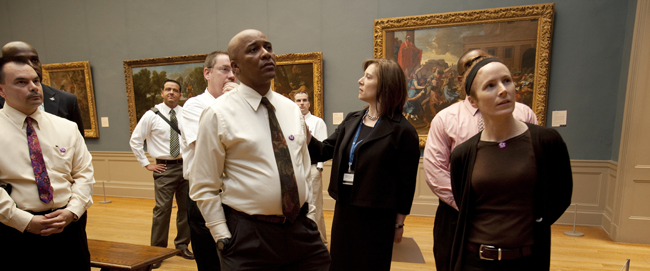
I became interested in Amy Herman’s work for several reasons. She harnesses the power of art to teach empathy, helping people in positions of power—be it medicine or law enforcement—relate more compassionately to the people they serve. Her programs also demonstrate yet another way museums can create financially sustainable services that advance the mission and improve society. The US spends about $15B each year to train doctors, and over $100B per year to train and maintain police forces. Shouldn’t museums, drawing a direct line from their resources to improved outcomes for these and other critical social needs, be included in that support? Today on the Blog, Amy tells us about the origins of the “Art of Perception.”
From across the room crowded with cubicles, monitors, and more armed individuals than I had ever seen in one place, a tall, intimidating FBI agent yelled, “Hey, there’s Amy Herman. She showed me my first Vermeer and I’ll never forget it. That light. I’ll just never forget it.” It’s working, I thought. It’s really working.
That was 12 years ago, long before I understood the powerful alchemy between art and law enforcement. Since then, the thin blue line—the institutional emblem of police forces worldwide—has appeared in museums everywhere.
Often, I must repeat what I do for a living. You teach police about art? Not exactly. I teach them to improve their observation and communication skills by learning to analyze works of art. Paintings, sculptures, and photographs have proven to be transformative tools in professional training programs for authorities in law enforcement, intelligence, and counterterrorism. Agencies from around the country and around the world are turning to museum collections to bolster their efforts to combat crime, terrorism, and unrest in our increasingly threatened and complex world.
In our country’s fractured cultural and political landscape, police officers’ roles have never been under greater scrutiny – and never have I had more respect for the men and women who keep our country, towns, homes, and schools safe. I wholeheartedly commit to use my own training as an art historian to help them make the excruciatingly difficult judgment calls and decisions that so often define their public service.
In 2001, as Head of Education at The Frick Collection, I instituted a program for medical students, The Art of Perception. Based on a model program at the Yale Center for British Art, the course took medical students from the clinical setting into an art museum to teach them to analyze works of art—big picture and small details—and articulate their observations. When they returned to the hospital, they would, we reasoned, be better observers of their patients. (You can find an assessment of the program in Bardes, Gillers, and Herman, “Learning to Look: Developing Clinical Observational Skills in an Art Museum, Medical Education, vol 35,no.12, pp.1157-1161.) Humanities in medical training has a strong historical precedent and this program underscored the value of critical thinking and visual analysis in the disciplines of both medicine and art history.
As we discussed the program over dinner a few years later, a friend suggested that I expand the application of this approach to other professionals for whom astute observation and perception skills were paramount.
Such as, I inquired?
Cops, he replied. They need great skills of observation and inference, don’t they?
That conversation led me to call the New York City Police Department the following morning. Transferred seven times, I finally reached a deputy commissioner who understood immediately the connection I articulated, and he agreed to come to the Frick to see what it was I was describing. Six months later, every newly promoted captain in the NYPD visited The Frick Collection to take The Art of Perception. I was elated with the new audiences, new insights, and a highly tailored program that was resonating with law enforcement professionals, many of whom had never set foot in a museum.
Although the Frick Collection might seem intimidating to first-time visitors, the police officers were engaged and eager learners. They embraced the works of Titian, Vermeer, and Bellini as their own, and saw the connections between examining works of art and improving their own observation and communication skills in a litany of professional scenarios—investigating crime scenes, questioning witnesses, writing reports, and testifying under oath, among others. While a group of officers viewed El Greco’s Purification of the Temple, I asked: If you could question any individual in the painting to get the backstory about what had just occurred, who would it be?” One officer responded, “I would collar the guy in the pink robe. He seems to be causing all the trouble.” The guy in the pink robe is Jesus Christ.
 |
| NYC police officers with Amy Herman at the Metropolitan Museum of Art from an article in Smithsonian Magazine, October 2009 (Amy Toensing) |
Not one to underestimate the power of art, I knew the program could expand to include additional concepts and broader audiences. By word of mouth, news of this training spread across the country, and increasingly I was asked to tailor the program for different agencies, focusing on such topics as surveillance, human trafficking, prosecution, the judiciary, and intelligence gathering. Over time, participants included the FBI, the Defense Department, the Department of Justice, and the Department of Homeland Security. I have led The Art of Perception in over 20 different museums and the number of participating institutions and law enforcement agencies continues to grow.
I also use these programs to address the critical need to cultivate empathy in law enforcement personnel and the communities they serve, in order to help improve the quality of interactions between them. To this end, I began to use more provocative works of art—photographs by Diane Arbus, paintings by Lucian Freud, and a selection of works by contemporary artists—to address issues of bias, prejudice, relationships, and race. Analysis of selected works of art became the entrée to substantive – and sometimes difficult – conversations about perceived threats and cultural distinctions, with an emphasis on behaviors grounded in assumptions, biases, and inferences. Proof that the technique works was evident in a comment from a surveillance agent, who told me at the end of a recent session: “You really opened my eyes. The problem is, I didn’t know they were closed.”
Museums can use their collections to improve the skills of police and intelligence community professionals and also to address longstanding cultural barriers. One police department at a time, those barriers are being dismantled via audience engagement that is helping to heal our fractured communities.
You can read more about the Art of Perception and Amy’s work “Visual Intelligence: Sharpen Your Perception, Change Your Life,” published this past spring.
Skip over related stories to continue reading article
You can read more about the Art of Perception and Amy’s work “Visual Intelligence: Sharpen Your Perception, Change Your Life,” published this past spring.









Fascinating program. Hope Torrents at the Lowe Art Museum, University of Miami has been doing some great work furthering these concepts with the School of Medicine at the University of Miami. The program is called "The Fine Art of Healthcare."
http://fineartofhealthcare.com/
Mark Osterman